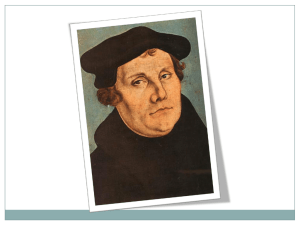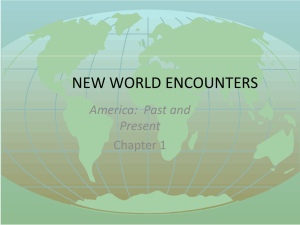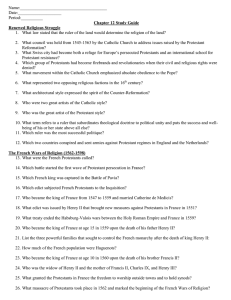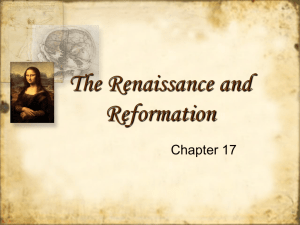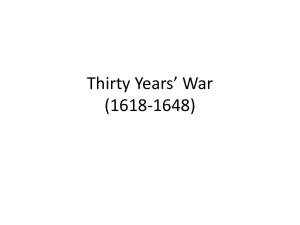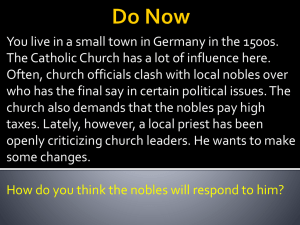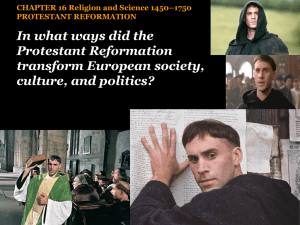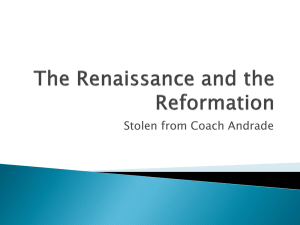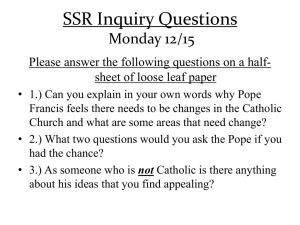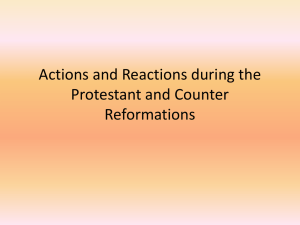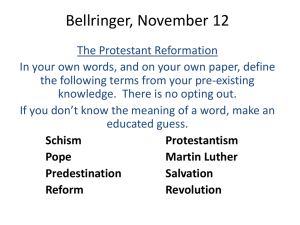UNIT 1: REFORMATION
advertisement
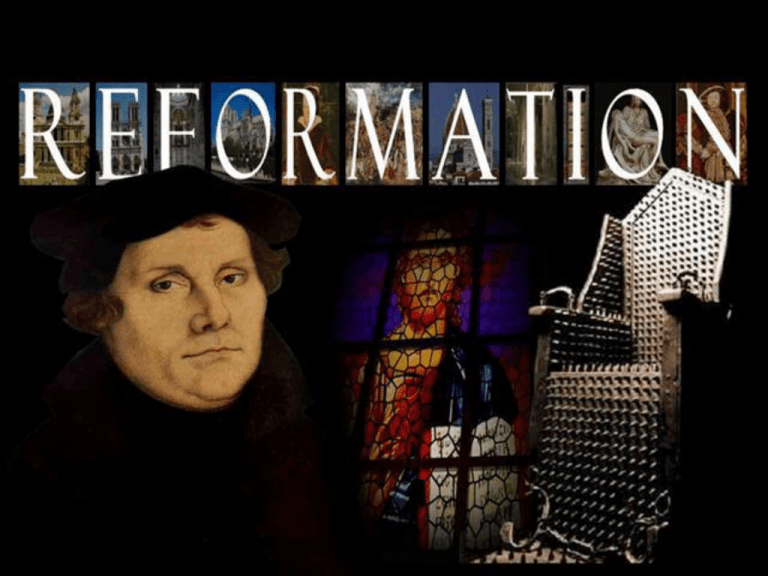
Thursday, 1/10/13 • THIS DAY IN HISTORY 4 Radical Reformers As the Reformation continued, hundreds of new Protestant sects sprang up. These sects often had ideas that were even more radical than those of Luther and Calvin. One radical group, the Anabaptists, rejected infant baptism. (They argued that infants are too young to understand what it means to accept the Christian faith.) Reasons for REFORM • Some Anabaptists wanted to abolish private property. • Others wanted use violence to speed up judgment day. • Most called for religious tolerance and separation of Church and state. • Despite harsh persecution, these groups influenced Protestant thinking in many countries. Today, the Baptists, Quakers, Mennonites, and Amish all trace their ancestry to the Anabaptists. Church of England: (The English Reformation • The Church of England, aka the Anglican Church (or Episcopalian Church in the US) was started because King Henry VIII wanted to get a divorce from his wife Catherine of Aragon. But the Catholic Church did not grant divorces. • Henry VIII created a new Church in 1534 based on the same doctrine as the Catholic Church but that allowed divorces. He then married Anne Boleyn. • Henry’s oldest daughter under his marriage with Catherine was named Mary. His daughter with Anne was named Elizabeth. • When Henry died, Mary was the rightful heir of the English crown. She had remained Catholic and so when she came into power, she tried to do away with the newly created Church of England. • Queen Mary I, who succeeded him, returned England again to the authority of the Pope, thereby ending the first attempt at an independent Church of England. During Mary's reign, many leaders and common people were burnt for their refusal to recant of their reformed faith. These are known as the Marian martyrs and the persecution has led to her nickname of "Bloody Mary". • Mary also died childless and so it was left to the new regime of her half-sister Elizabeth to resolve the direction of the church. • For years, Elizabeth had survived court intrigues, including the religious swings under Edward (yes, Henry did eventually have a son!) and Mary. As queen, Elizabeth had to determine the future of the Church of England. She slowly enforced a series of reforms that later were called the Elizabethan settlement. • The settlement under Elizabeth I (from 1558), was known as the Elizabethan settlement. The queen’s policies were a compromise, or acceptable middle ground, between Protestant and Catholic practices. • The Church continued to thrive under Queen Elizabeth and has remained, even today, as the official church of the country of England. 4 England and the Church In 1528, King Henry VIII asked the pope to annul, or cancel, his marriage. The pope refused Henry’s request. Henry took the Church from the pope’s control and created the Church of England. Protestant King Edward VI brought Protestant reforms to England. Queen Mary wanted to restore Catholicism to England. She had hundreds of English Protestants burned at the stake. Queen Elizabeth forged a compromise between Protestants and Catholics. • English Reformation Counter Reformation: • The Counter Reformation is also known as the Catholic Reformation. It was started because Pope Paul III wanted to reform the Catholic Church so that people would quit leaving the Catholic Church and becoming Protestant. • The movement was started by a meeting of Church officials in something called the Council of Trent. • Pope Paul III set out to revive the moral authority of the Church and roll back the Protestant tide. To accomplish these goals, he: – Called for The Council of Trent to establish the direction that reform should take – (1545) met off and on for almost 20 years – Took steps to end abuses in the church – Established schools to better educate clergy to challenge Protestant teachings Strengthened Inquisition – Strengthened the Inquisition (what’s that?) – A Church court set up during the Middle Ages – Used secret testimony, torture, and execution to root out heresy – Prepared the Index of Forbidden Books (a list of works considered too immoral or irreligious for Catholics to read) Jesuits – Recognized a new religious order, the Jesuits, (Society of Jesus) to combat heresy and spread the Catholic faith. Many daring Jesuits disguised themselves and ventured into Protestant lands to minister to the spiritual needs of Catholics Effects of the Protestant Reformation 4 Immediate Effects Peasants’ Revolt Founding of Lutheran, Calvinist, Anglican, Presbyterian, and other Protestant churches Weakening of Holy Roman Empire Luther calls for Jews to be expelled from Christian lands Long-Term Effects Religious wars in Europe Catholic Reformation Strengthening of the Inquisition Jewish migration to Eastern Europe Increased antisemitism 4 Widespread Persecution During this period of heightened religious passion, both Catholics and Protestants fostered intolerance. Catholics killed Protestants and Protestants killed Catholics. Between 1450 and 1750, tens of thousands of people, mostly women, died as victims of witch hunts. In some places, Jews were forced to live in ghettos, or separate quarters of the city. In other places, they were expelled from Christian lands and their books and synagogues were burned. Major European Religions about 1600 4 4 Which English monarch had thousands of Protestants burned at the stake? a) Elizabeth b) Mary c) Henry VIII d) Edward VI Which of the following was not an effect of the Protestant Reformation? a) the Catholic Reformation b) Increased anti-Semitism c) religious wars in Europe d) the invention of the printing press 4 Which English monarch had thousands of Protestants burned at the stake? a) Elizabeth b) Mary c) Henry VIII d) Edward VI Which of the following was not an effect of the Protestant Reformation? a) the Catholic Reformation b) Increased anti-Semitism c) religious wars in Europe d) the invention of the printing press
